PAUL WILLIAMS
BUGSY
MALONE JUNIOR
THE BROADWAY JUNIOR COLLECTIONTM
DIRECTOR'S GUIDE
1999
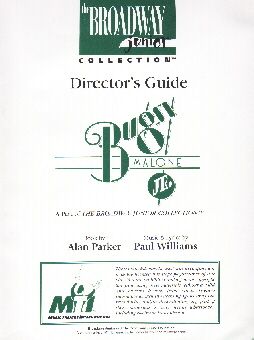
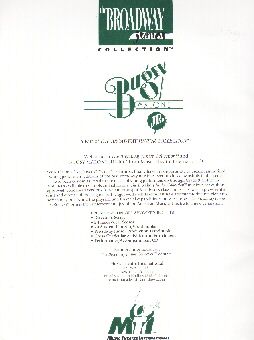


My Introduction To Bugsy Malone Jr.™
Back in 1999 I was contacted by a representative from MTI (Music Theatre International) who told me that he was putting together a 'Director's Guide' to Bugsy Malone Jr™, for use by youth groups wanting to put on a stage production of Bugsy Malone. This guide, with it's accompanying Performance/Guide Vocal CD, was to be part of MTI's Broadway Junior Collection™.
I was asked whether I would mind them using some of the background information from these Paul Williams Music and Acting web pages, to use as some of the background information on Paul in the guide. I said I was happy to oblige and glad to be able to contribute, in my own small way, to such a great publication. Some months later when I received a complimentary copy of 'Director's Guide' to Bugsy Malone Jr™, with it's accompanying Performance/Guide Vocal CD, I was honoured to see printed on the first page 'Special Thanks to David Chamberlayne'. My contact at MTI had also written on the inside front cover:
"Dear David,
Your kind help and expertise have been invaluable in the preparation of this Guide! Kids everywhere will share in this wonderful music.
Thank you, so much!!
Best wishes
Fred Stuart"
Broadway Junior CollectionTM have developed an excellent web page themselves about the 'Director's Guide' to Bugsy Malone Jr™ here. I thought that I would also like to give some details of what you can find in this wonderful Guide. It is a fascinating book if you are a fan of Bugsy Malone, but especially if you live in the U.S.A. and are thinking of putting on a young people's production of Bugsy Malone. Some the photos on this page, produced here from the guide, are courtesy of the Lincoln Community Playhouse.
Thanks to Fred Stuart for permission to publish the following information from the guide.
Welcome to The Broadway Junior
CollectionTM
and
BUGSY MALONE JUNIOR from Music Theatre
International!
BROADWAY JUNIORTM SHOWKITS
INCLUDE:
· Director's Guide / Script
· 2 Piano / Vocal Scores
· 20
Student Libretto / Vocal Books
· Broadway Junior Production Handbook
·
Cross-Curricular Activities and Enrichment
· Performance / Accompaniment
CD
For a brief summary of what is included in the above take a look at the 'What's In The Box' page of the Broadway Junior CollectionTM web page.
What follows are extracts from the Director's Guide / Script and Performance / Accompaniment CD
Notes on Directing
Bugsy Malone Junior
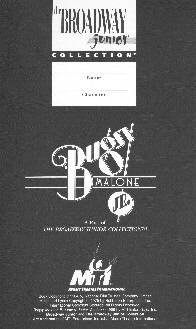
Bugsy Malone Junior should be a great deal of fun to direct! The overall idea of the show is to tip your hat to the classic Hollywood gangster films of the 1 930s. Some titles you may want to watch to prepare for your production include: Public Enemy (Warner Brothers, 1931), Little Caesar (Warner Brothers, 1930) and Scarface (Caddo, 1932). These films will give you an idea of the original style which you will want to spoof. Bugsy Malone is loaded with clichés and references to these old film greats, so you will want to be familiar with the genre. James Cagney, Edward G. Robinson, Humphrey Bogart, Jean Harlow; Lauren Bacall and Ann Dvorak are wonderful examples of actors with a distinct acting style that you should try to impart to your cast. The key to Bugsy Malone Junior is to have fun, stay focused on the story and deliver the gags!
Listed below is the Table Of Contents from the Guide. The sections underlined I have included on this page...for the rest you will have to just buy the guide :)
- Introduction (Pages
4-5)
Using
This Book
Your
Performance License
About
Music Theatre International
- About Bugsy Malone Junior (Pages 6-8)
A
Brief History of Bugsy Malone Junior
The
Plot
Selected
Discography
About
the Creators
Bugsy
Malone Facts
- Director's Guide to Bugsy Malone
Junior (Pages 9-27)
Preparing
For Your Production
Notes
on Directing Bugsy Malone Junior
Casting
Suggestions
Getting Everyone
Involved
Rehearsals
Setting up
a Rehearsal
Schedule
Suggestions for Theatre Games
Set
Suggestions
Lighting
Suggestions
Costume
Suggestions
Prop
Suggestions
Suggested Prop
List
A
Note On Splurging
Choreography
Suggestions
Using the Performance/Accompaniment CD
Using
the Guide Vocals CD
Publicity
Suggestions
Program Suggestions
- Actor's Introduction and Libretto
(Pages 33-66)
The Actor's Production
Pages
Table of Contents
Songs By Character
Characters
To the Actor
How to Start Talking Like a Big shot Actor
How to
Destroy Your Script Like a Professional.
What to
Expect in Rehearsals
A Final
Word
Scene/Character
Breakdown
Rehearsal
Calendar
Notes on Bugsy Malone
Junior
About the creators
- THE SHOW
(This section gives
the full director's script,
staging
notes included in the margin of script throughout, and page numbers
cross-referenced to student books. For examples of pages from this script take a
look at the 'Audition Central' pages of the
Broadway Junior CollectionTM
here)
SCENE ONE
#1 Opening
(Orchestra)
#2 After Splurge (1) (Orchestra)
#3 After Splurge
(2) (Orchestra)
#4 Bugsy Malone (Company)
#5 Fat
Sam's Grand Slam (Company)
#6 Razamataz! (Orchestra)
#7
Grand Slam Playoff (Orchestra)
SCENE TWO
#8 Change to Scene
3 (Orchestra)
SCENE THREE
#9
That’s Wby They Call Him Dandy....(Dandy and his Gang)
#10
Tomorrow (Fizzy)
SCENE
FOUR
#11 Show Business (Lena, Chorus)
#12 Show
Business Playoff (Orchestra)
SCENE
FIVE
#13 Bad Guys (Fat Sam's Gang)
#14
Bad Guys Playoff (Orchestra)
SCENE SIX
#15 After Splurge
(3) (Orchestra)
#16 I'm Feeling Fine
('3lousey)
#17 I'm Feeling Fine Playoff (Orchestra)
SCENE
SEVEN
#18
Splurged! (Orchestra)
#19 Change to Scene
8 (Orchestra)
SCENE EIGHT
#20 My Name Is
Tallula (Tallulah and the Girls)
SCENE NINE
#21 I'm
Feeling Fine Underscore (Orchestra)
#22 Change to Scene
10 (Orchestra)
SCENE TEN
SCENE ELEVEN
#23 Ordinary
Fool (Blousey)
#24 Ordinary Fool
Playoff (Orchestra)
SCENE TWELVE
#25 Change to Scene
13 (Orchestra)
SCENE THIRTEEN
#26 Down and Out
(The Down and Outs)
#27 Down and Out
Playoff (Orchestra)
SCENE FOURTEEN
#28 Fat
Sam's Grand Slam-Reprise (Company)
#29 You Give a Little Love
(Company)
#30 Bows and Exit (Orchestra)
This book is
intended to serve as a guide for the production's director, although it also
contains information which your producer; music director, choreographer and
designers (we'll call them your production team) may find useful. If at this
point you are thinking to yourself, “what if all those people are really just
me” don't worry, this book is designed with you in mind as well! You will find
background information on the show as well as suggestions on holding
auditions, casting, running rehearsals, directing and staging the show, creating
the set, costumes, lighting and props, using the accompaniment CD,
assembling the program and publicizing the production. Beginning directors may
use this guide as a blueprint on which to build their own production.
Experienced directors may use the resources in this book to cut down on
preparation time, leaving them free to concentrate on delivering the best
production possible.
The Directors
Guide is divided into four sections: the “Introduction” which offers
information on how to use this book and the nature of your performance license;
“About your show” which includes a plot summary and background information on
the show, its source material and authors; the “Director's Guide” which offers
general suggestions on the various aspects of your production; and a section
titled “The Show,” consisting of the introduction and libretto sections
from the Libretto/Vocal book, annotated with specific suggestions on
directing, staging, rehearsing and lighting the show, moment by moment (for
quick reference, icons have been used to indicate the subject of each
annotation-e.g., a director's clipboard for directors' notes).
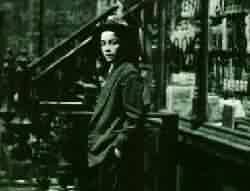
We suggest you begin by reading the “Introduction” which you are if you are reading this! (You see, great minds think alike!) Next read “About your show” to familiarize yourself with the show. You should then SKIP TO THE LAST SECTION OF THE BOOK ("The Show") to study the script and other contents of the actors’ libretto. The inset libretto pages in this section appear exactly as they do in the actors' books, down to the page numbers at the top of each inset page. Consider reading the "To the actor" section of the libretto with your entire group, to make sure everyone is familiar with the important theatrical terms discussed and the rehearsal process described.
If you are a beginning director, you should then read the Broadway Junior™ Production Handbook included in this Showkit, if you have not already done so. Even if you are an experienced director, leaf through the Broadway Junior™ Production Handbook--it's a great guide to theatre production and you may learn something you didn't know about putting on a show Then read the "Director's Guide" section of this book, sharing all relevant information with your production team. Finally, re-read the final section of this book, concentrating on the Director's Guide annotations and taking notes in the margins of each page in pencil as you may change your notes as your production progresses.
If you are
serving as director and music director you should take one of the two
piano/vocal scores provided in the showkit and use it in tandem with the
Director's Guide. The other piano/vocal score should be given to the
rehearsal pianist, if one is available.
A final note to the director: peruse the Cross Curricular Activities and Enrichment book included in the showkit, even if you do not intend to integrate your production into a school curriculum. The book contains a number of exercises and activities that may help your actors (and you) better understand the show.
A Brief History and Facts about Bugsy Malone.
Film director Alan Parker first had the idea of a gangster film featuring an all kid cast in 1973.Though meeting with little encouragement from the film industry, Parker persevered and a year later began work on a script that would become the film, "Bugsy Malone." A team of producers rounded up enough money to develop the project and Parker went to show business legend Paul Williams to commission the score for the film. Parker searched all over Britain for American children who happened to live in the U.K., mostly on Air Force bases, and in schools throughout New York City. Over the year 1974-75 over 10,000 children auditioned for the film!
The process of making the film is best summed up by the writer/director himself, Alan Parker: "... filming for thirteen weeks, making over 300 specially cut-down costumes, designing a complete 1929 New York street set, setting up a full-time school for lessons in between scenes, finding ways of making the cars and the splurge guns nearly work, getting child work permits from two countries... and we were on our way. A thousand custard pies and 100 gallons of synthetic cream later we had our film." The movie version starred then unknown Scott Baio and child star Jodie Foster and a supporting cast of over 200.
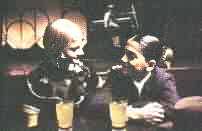
After the film's release and subsequent box office and home video and television success, Parker began to receive countless requests for a stage version so that schools and dramatic groups could present the story. Parker wrote the stage version in the early 1980s.
In 1997, England's National Youth Music Theatre, supported by Andrew Lloyd Webber, presented Bugsy Malone on London's famed West End (the British equivalent of Broadway) at the Queen's Theatre.Long a favorite of the British amateur stage, Bugsy Malone was finally released in North America by Music Theatre International in 1999. The North American premiere of the Broadway Junior Collection version, Bugsy Malone Junior premiered at the Lincoln Community Playhouse in Lincoln, Nebraska in July of 1999 under the direction of Rhonda Lake.
In this version of Bugsy Malone Junior the show is broken down into 14 Scenes. Here is the plot line for Scene 1
Scene 1
As the curtain rises, we hear Bugsy Malone narrate the following action: A young member of New York kingpin Fat Sam's outfit is cornered by rival hoods. They question him, then-splat! He is 'splurged' with a mysterious new weapon that fires whipped cream! The hoods exit and we see lawyer Flash Frankie getting a haircut. The hoods re-enter and-splat! Frankie is splurged with the same new weapon. Bugsy enters and comments on the curious action. The girls introduce Bugsy with, "Bugsy Malone." Bugsy meets Blousey, the wide-eyed new girl in town.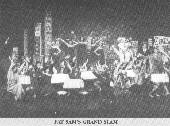
The Guide itself gives many useful tips to help when choosing the cast for the show. The Broadway Junior CollectionTM have web pages designed to be downloaded by the director and auditioning actors of the show for audition purposes only. These materials may only be used in conjunction with a performance license of an individual show. For more information on securing a performance license, please click here. Any other use is a violation of the copyright law and strictly prohibited. Here is what it has to say about some of the characters:
BUGSY MALONE
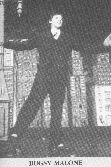 Bugsy is the hero of our story. Cast a handsome young man who can sing
and act well. This role is equal parts Jimmy Stewart, James Bond and Gene Kelly.
Bugsy alternates as the narrator and the star of the show A young performer
at home in front of an audience who radiates a sense of charm and sincerity as
well as a street-wise sensibility will take your show a long way towards
success.
Bugsy is the hero of our story. Cast a handsome young man who can sing
and act well. This role is equal parts Jimmy Stewart, James Bond and Gene Kelly.
Bugsy alternates as the narrator and the star of the show A young performer
at home in front of an audience who radiates a sense of charm and sincerity as
well as a street-wise sensibility will take your show a long way towards
success.
Vocal range: C# to D (Baritone-Tenor)
BLOUSEY BROWN
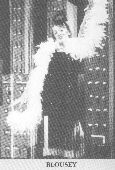
Vocal range: Low G to F (Soprano)
Suggested vocal
audition:
#16 "I'm Feeling Fine": All #23
"Ordinary Fool": All
Suggested dialogue
audition:
Scene 1, pp. 42-43
Scene 2, pp.47-48
FAT SAM
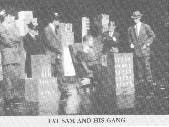
Vocal range: F# to F (Husky Baritone)
Suggested vocal
audition:
#29 You Give A Little Love":
measures 10-17
Suggested dialogue
audition:
Scene 1, pp.44-46
Scene 6, pp.68-70
TAIIULAH
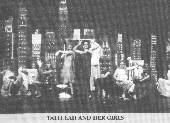 Tallulah is the classic gangster's moll. Cast a
young woman who is at home with herself and can deliver the role with deadpan
sincerity and droll appeal. Tallulah is a Mae West type with a talent for
performing. She needs to be a strong singer for her self-titled
number.
Tallulah is the classic gangster's moll. Cast a
young woman who is at home with herself and can deliver the role with deadpan
sincerity and droll appeal. Tallulah is a Mae West type with a talent for
performing. She needs to be a strong singer for her self-titled
number.
Vocal range: B to B (Breathy Alto)
DANDY DAN
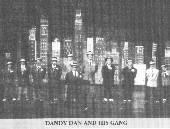 Dandy Dan is the unflappably stylish, debonair
underworld businessman who outwits Fat Sam every step of the way. Your Dan
should be at home singing his song, "That's Why They Call Him Dandy." Find an
actor with just the right sense of style and grace.
Dandy Dan is the unflappably stylish, debonair
underworld businessman who outwits Fat Sam every step of the way. Your Dan
should be at home singing his song, "That's Why They Call Him Dandy." Find an
actor with just the right sense of style and grace.
Vocal range: Low G to B (High Tenor)
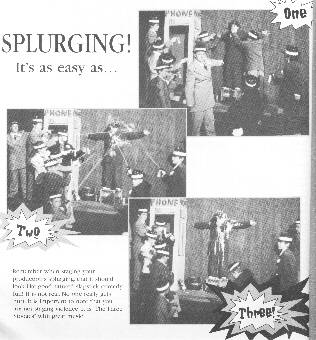
Splurging is Bugsy Malone Junior terminology for taking somebody out'. In the gangster films that meant death. Thankfully, in the world of Bugsy Malone Junior, if someone is splurged' it means they are 'all washed up'. Though not fatal, splurging is the end of one's career as a gangster or hoodlum.
For stage purposes,
splurging can be achieved in a number of ways. In our Broadway Junior test
sights Super StringTM was used with great effect. By
building small casements for the Silly String dispensers, they can be used
throughout the show, wherever there is a splurge incident. This stuff cleans up
very easily, which is a big consideration in Bugsy Malone
Junior!
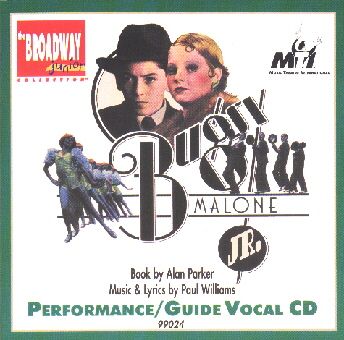
This CD contains both the background music for the show, along with guide vocals featuring the voices of The French Woods Festival of the Performing Arts.
Using the Performance/Accompaniment CD
The CD included in your
showkit contains all of the music for the Broadway
JuniorTM version of your show. Each musical number has been indexed
separately. The numbering of the accompaniment tracks corresponds to the
numbering of the black bars in the show's libretto.
The person operating the CD
player for your production is a key player. Optimally, the music director should
conduct the actors and an assistant would run the CD player. Your CD operator
should attend several early rehearsals, production meetings and every technical
rehearsal. A libretto and score with precisely marked cues should be in front of
the CD operator. This person can also be responsible for running pre-show music
and any other sound concerns. If you have a lighting board, you may want to put
the sound equipment on the same table.
For performances, hit the
"play" button on your CD player at the beginning of the show; the "pause" button
each time you begin or end a musical number as you may find yourself more error
prone if you press stop and play throughout the show.
Create cue sheets to keep
track of when to play and pause the CD during rehearsals and performances. Set
the volume level for each musical number during technical rehearsals, and
mark the cue sheets accordingly. Also indicate if any tracks (e.g. the "scene
change' tracks) are to be repeated multiple times, and the number of times they
are to be repeated. Included is a sample sound cue sheet and a blank one to
photocopy and use for your production.
Using the Guide Vocals CD
The guide vocals tracks follow the performance tracks. These vocal tracks may be used to help teach parts as well as demonstrate the style demanded by each song. Your Guide Vocal CD includes the same performance tracks with example vocals provided to aid you in teaching the music. You may make cassette copies of the songs as a teaching aid for your young performers.
PERFORMANCE
[1] Opening
[2] After
Splurge
[3] After Splurge (2)
[4] Bugsy Malone
[5] Fat Sam's Grand
Slam
[6] Razamataz!
[7] Grand Siam Playoff
[8] Change To
Scene3
[9] That's Why They Call Him Dandy
[10] Tomorrow
[11] Show
Business
[12] Show Business Playoff
[13] Bad Guys
[14] Bad Guys
Playoff
[15] After Splurge (3)
[16] I'm Feeling Fine
[17] I'm Feeling
Fine Playoff
[18] Splurged!
[19] Change To Scene 8
[20] My Name Is
Tallulah
[21] I'm Feeling Fine Underscore
[22] Change To Scene lO
[23]
Ordinary Fool
[24] Ordinary Fool Playoff
[25] Change To Scene13
[26]
Down And Out
[27] Down And Out Playoff
[28] Fat Sam's Grand Slam
Reprise
[29] You Give A Little Love
[30] Bows And Exit
GUIDE
VOCALS
[31] Opening
[321 Bugsy Malone
[33] Fat Sam's Grand Slam
[34]
That’s Why Thy Call Him Dandy Dan
[35] Tomorrow
[36] Show Business
[37]
Bad Guys
[38] I’m Feeling Fine
[39] I’ m Feeling Fine (Dialogue)
[40]
My Name Is Tallulah
[41] Ordinary Fool
[42] Down And Out
[43] Fat Sam's
Grand Slam Reprise
[44] You Give A Little Love
ALAN PARKER (Librettist)
Alan Parker is a
world renowned film director and writer In addition to "Bugsy Malone"
(1976), Parker is responsible for such cinematic blockbusters as "Fame" (1980),
"Pink Floyd: The Wall" (1982), "Birdy" (1984), "Mississippi Burning" (1988),
"The Commitments" (1991), and "Evita" (1996). Parker said of filming "Bugsy
Malone" with a cast of 200 kids, "I said from the beginning we weren't making
just a kid's film. I treated them like adults and so expected them to behave
like adults. And, all in all, it worked out very well. Perhaps they didn't hit
their marks as often as they ought to, but then again we didn't get any grown-up
tantrums either!"
Paul Williams is an equally acclaimed composer; singer and actor. His song writing credits include 'just An Old Fashioned Love Song," the Carpenters' hit "We've Only Just Begun." He wrote the lyrics for the 1976 Oscar winner for Best Song, "Evergreen" (from "A Star is Born"). His songs have been performed by a wide variety of artists including Barbra Streisand, Luther Vandross, Kenny Loggins, David Bowie, Cracker; Grant Lee Buffalo, Frank Sinatra, Mathew Sweet and Elvis Presley. Paul co-wrote the title song for "The Secret of Nimh," which he also performed. Mr. Williams has released 19 albums, been nominated for six Oscars and ten Grammys (winning for "Evergreen" and Producer of Best Recording For Children ("The Muppet Movie"). As an actor; he has been seen in a variety of television shows and his hilarious portrayal of Little Enos in all three "Smokey and the Bandit" films. An active songwriter today, he continues to write music and lyrics for performers everywhere while touring himself and he provides the voice of the Penguin on the animated television series "Batman."
Contact Details and Licensing Information
About Music Theatre
International
Music Theatre
International (MTI) is a theatrical licensing agency created by orchestrate Don
Walker and composer-lyricist Frank Loesser to help theatre writers license
their shows for live stage performance to schools, community and professional
theaters around the country.
On behalf of the
show's authors, MTI issues a performance license to theatre groups which gives
them the right to perform and present a musical theatre work as a live stage
production. MTI also provides all materials necessary to produce the work, as
well as additional resources that aid in the rehearsal process and enhance the
final production.
Tel: 212 541 4684
email:
BroadwayJr@mtishows.comweb page:
http://www.mtishows.com/show_home.asp?id=000214These materials may be used only in conjunction with the licensed live stage performance of this play. You are prohibited under federal copyright law from using these materials without a current license from Music Theatre International, exclusive licensing agent, and from reproducing and / or disseminating any part of these materials by any means whatsoever, including electronic transmission.
After creating a
show, theatre writers copyright their work, protecting their ownership of it and
allowing them-and only them or their duly appointed representative-to
decide who may perform the show, where it may be performed, how it may be
performed and how much will be charged for the privilege of using their work.
This dramatic performance right (or "grand right") is known as an "intellectual
property right"; the show is the "intellectual property" of the
authors.
On their behalf,
Music Theatre International (MTI) grants a performance license to produce the
show and collects a fee, known as a "royalty;" for this license. Royalties are
the authors' way of being paid for the use of their show, and are determined by
careful evaluation of the dates and times of an organization's performances, and
the number and prices of the tickets that organization plans to
sell.
MTI's other
responsibilities include enforcing copyright law as it pertains to grand rights,
including enforcing unlicensed productions (presenting the show without a
performance license is akin to cheating the authors out of their livelihood) and
prohibiting unauthorized changes to the show The Broadway Junior~ version of
your show has been approved by the show's authors and is the only authorized
condensed version of the show. Some people think making "minor adjustments" to a
show (such as changing the gender of a character, inserting songs that have been
edited from the Broadway Junior ™ version, or changing the name of a town to
give it local significance) is inconsequential to the integrity of the show; or
believe they have the right to “experiment” with the authors' intentions as an
expression of their artistic vision. This is simply not the case. You have no
right to make any changes at all unless you have obtained prior written
permission from the authors or MTI to do so. Altering the show in any
unauthorized manner is unfair to the authors and the show itself. Moreover; such
actions will subject you to liability-not only to the authors, but also to
MTI-for breaching the terms of your license agreement, which clearly forbids you
to make any changes or deletions.
Ultimately, you must remember that a theatrical production is a collaboration between the authors of a show and the organization presenting it. Your responsibility in that collaboration is to realize the show as the authors conceived it.
License Application
© 1998-2000 MTI Enterprises, Inc.
d/b/a Music Theatre
International
- Track Listing For "Bugsy Malone"
- Comments on the ten songs in "Bugsy Malone"
- What Alan Parker (Film Director) said about Paul Williams involvement in "Bugsy Malone"
- Where to get the sheet music for "Bugsy Malone"
- "Bugsy Malone" Press Kit (Part One) - including 'Synopsis,' 'The Main Players,' 'The Soundtrack Album' and 'The Paperback Book'
- Information on the National Youth Music Theatre' stage production of "Bugsy Malone"
 Return to Paul Williams'
Music and Acting Home Page
Return to Paul Williams'
Music and Acting Home Page
Email me, David Chamberlayne, at: